Uncategorized
Crypto Daybook Americas: Bitcoin Traders on Edge Ahead of Trump’s Make or Break Crypto Summit
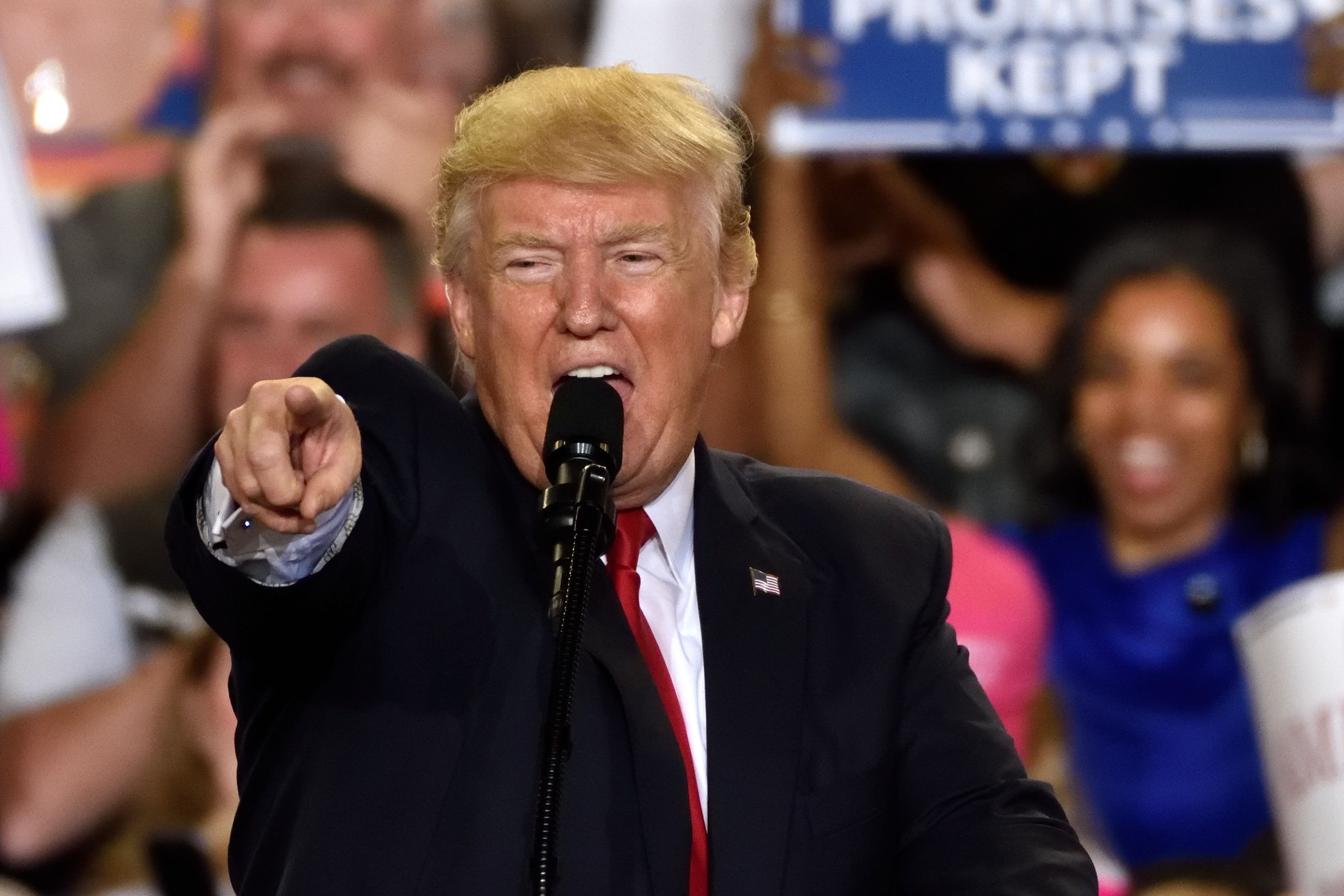
By Omkar Godbole (All times ET unless indicated otherwise)
Both traditional and crypto markets have stabilized in the past 48 hours, but key volatility indices remain elevated, calling for caution for bulls who are expecting a steady move higher.
Bitcoin, the crypto market leader, briefly topped $92,700, extending the recovery from lows around $81,500 on Tuesday. MOVE, CRO, ONDO and Render traded 10% to 17% higher as of writing. Broadly speaking, AI, gaming and Layer 2 coins are the best-performing crypto sub-sectors for the past 24 hours.
The positive move could be attributed to rumors that President Donald Trump will unveil a U.S. strategic bitcoin reserve during Friday’s White House crypto summit. Meanwhile, hopes that Trump’s tariffs will likely not endure have helped restore the risk sentiment on Wall Street and Germany and China’s fiscal rockets have offered support to Asian and European equities.
Still, we haven’t seen a notable decline in the volatility indices. At press time, Volmex’s BVIV index, which measures the implied or expected 30-day price turbulence, held just five points below Tuesday’s high of 66% but well above the February low of 49.6%. Perhaps traders see Friday’s crypto summit as the make-or-break moment for crypto, as the President, having promised big for months, is now expected to deliver the goods as soon as possible.
In traditional markets, VIX, Wall Street’s fear gauge, held at 23.65 Wednesday, the highest since mid-December, according to data source TradingView. Meanwhile, the MOVE index, which measures the 30-expected volatility in the U.S. Treasury notes, remained elevated at 104, the highest since November (check chart of the day).
The elevated volatility in bonds is particularly concerning as it is known to cause financial tightening and weigh over risk assets. For now, however, a weaker dollar seems to be compensating for that.
Still, the sticky vol indices in traditional markets raise an important question: Is the market’s concern solely about tariffs, or are there underlying worries related to a significant slowdown driven by other factors such as potential fiscal consolidation?
The spread between yields on the U.S. 10-year Treasury note and the three-month Treasury bill has again turned negative, inverting the yield curve to suggest recession — consecutive quarterly contractions in the GDP. «[This is] generally not a good sign,» Noelle Acheson, author of the Crypto is Macro Now newsletter said in Wednesday’s edition.
Early this week, the Atlanta Fed’s GDPNow model signaled a nearly 3% contraction in the U.S. GDP in the first quarter. The number is due for an update today. Recession fears will likely strengthen if we don’t see an improvement today, potentially pressuring risk assets, including cryptocurrencies.
Acheson summed up the situation best: «We are still navigating the tussle between narratives – on the one hand, risk-off sentiment driven by macro uncertainty could keep BTC and other crypto assets depressed for a while. On the other hand, the “safe haven” narrative is gaining strength, as positive news from the White House highlights the astonishing shift in official support.» Stay alert!
What to Watch
Crypto:
March 6: Ethereum-based L2 blockchain MegaETH deploys its public testnet, with user onboarding starting on March 10.
March 6: Quantify Funds’ STKd 100% MSTR & 100% COIN ETF (APED) gets listed on Nasdaq.
March 7: President Trump will host the inaugural White House Crypto Summit, bringing together top cryptocurrency founders, CEOs and investors.
March 11: The Bitcoin Policy Institute and U.S. Senator Cynthia Lummis co-host the invitation-only one-day event «Bitcoin for America» in Washington.
March 12: Hemi, an L2 blockchain that operates on both Bitcoin and Ethereum, has its mainnet launch.
March 14: Pi Network (PI) transitions from Enclosed Mainnet to Open Mainnet.
March 15: Athene Network (ATH) mainnet launch.
March 16, 6:00 p.m.: CME Group’s solana (SOL) futures start trading.
Macro
March 6, 8:15 a.m.: The European Central Bank (ECB) Governing Council will announce its interest rate decision. Press conference (livestream link) at 8:45 a.m. The Monetary policy statement is released at 9:00 a.m. The ECB staff macroeconomic projections are released at 9:45 a.m.
Deposit Facility Rate Est. 2.5% vs. Prev. 2.75%
Main Refinancing Rate Est. 2.65% vs. Prev. 2.9%
Marginal Lending Rate Prev. 3.15%
March 6, 8:30 a.m.: The U.S. Department of Labor releases employment data for the week that ended March 1.
Initial Jobless Claims Est. 235K vs. Prev. 242K.
March 7, 7:00 a.m.: Mexico’s Instituto Nacional de Estadística y Geografía (INEGI) releases February consumer price inflation data.
Core Inflation Rate MoM 0.46% vs. Prev. 0.41%
Core Inflation Rate YoY Est. 3.62% vs. Prev. 3.66%
Inflation Rate MoM Est. 0.27% vs. Prev. 0.29%
Inflation Rate YoY Est. 3.77% vs. Prev. 3.59%
March 7, 8:30 a.m.: Statistics Canada releases February employment data.
Unemployment Rate Est. 6.7% vs. Prev. 6.6%
Employment Change Est. 20K vs. Prev. 76K
March 7, 8:30 a.m.: The U.S. Labor Bureau of Statistics (LBS) releases February employment data.
Nonfarm Payrolls Est. 160K vs. Prev. 143K
Unemployment Rate Est. 4% vs. Prev. 4%
March 8, 8:30 p.m.: The National Bureau of Statistics of China releases consumer price inflation data (CPI) and producer price inflation data (PPI).
Inflation Rate MoM Prev. 0.7%
Inflation Rate YoY Prev. 0.5%
PPI YoY Prev. -2.3%
Earnings (Ests. based on FactSet data)
March 6 (TBC): Bitfarms (BITF), $-0.06
March 17 (TBC): Bit Digital (BTBT), $-0.05
March 18 (TBC): TeraWulf (WULF), $-0.04
March 24 (TBC): Galaxy Digital Holdings (TSE: GLXY), C$0.39
Token Events
Governance votes & calls
Aave DAO is discussing the introduction of sGHO, a yield-bearing token that allows users to earn the Aave Savings Rate (ASR) by depositing GHO stablecoins.
Sandbox DAO is discussing establishing the Sandbox DAO Grants Program to distribute funding to projects more efficiently.
March 6, 8:30 a.m.: GMX to hold a Governance Community Call for the GMX DAO.
March 6, 10 a.m.: Near Protocol to host a Town Hall.
March 7, 10 a.m.: Maple to host an X Spaces where an “exciting announcement” will be revealed.
Unlocks
March 7: Kaspa (KAS) to unlock 0.63% of circulating supply worth $12.43 million.
March 9: Movement (MOVE) to unlock 2.08% of its circulating supply worth $24.45 million.
March 12: Aptos (APT) to unlock 1.93% of circulating supply worth $70.12 million.
March 15: Starknet (STRK) to unlock 2.33% of its circulating supply worth $12.42 million.
March 15: Sei (SEI) to unlock 1.19% of its circulating supply worth $12.88 million.
March 16: Arbitrum (ARB) to unlock 2.1% of its circulating supply worth $39.46 million.
Token Listings
March 6: Roam (ROAM) to be listed on KuCoin and MEXC.
March 6: Renzo (REZ) to be listed on Coinbase.
March 6: Redstone (RED) to be listed on KuCoin, LBank, BingX, and Bybit.
March 6: Magic Eden (ME) to be listed on Binance.US
Conferences
CoinDesk’s Consensus is taking place in Toronto on May 14-16. Use code DAYBOOK and save 15% on passes.
Day 3 of 4: FIN/SUM 2025 (Tokyo)
March 8: Bitcoin Alive (Sydney)
March 10-11: MoneyLIVE Summit (London)
March 13-14: Web3 Amsterdam ‘25
March 19-20: Next Block Expo (Warsaw, Poland)
March 25-27: Mining Disrupt (Fort Lauderdale, Fla.)
March 26: DC Blockchain Summit 2025 (Washington)
March 28: Solana APEX (Cape Town, South Africa)
Token Talk
By Shaurya Malwa
Aave, a leading Ethereum-based lending protocol, is conducting a community check for «sGHO,» a low-risk savings product built around its native GHO stablecoin and a new «Aave Savings Rate,» to expand rewards for holders.
sGHO aims to provide users with a yield-bearing ERC-20 token by depositing GHO, with the savings rate tied to the native yield from a USDC pool on Aave’s V3.
The launch of sGHO, featuring no withdrawal or deposit fees, is part of Aave DAO’s aggressive growth strategy to drive GHO adoption during a depressed yield market.
Alongside sGHO, Aave is pursuing other initiatives to expand GHO’s user base, such as introducing it as a gas token across different blockchains and integrating it into various ecosystems, while also approving a treasury rebalancing to reduce risks and improve liquidity on Aave v3.
Derivatives Positioning
Funding rates for most major tokens, except ADA, XRP and TON, are positive, per data source Velo Data. The negative figure for the three coins suggests bias for shorts and potential for a short squeeze should the spot price hold resilient.
BTC, ETH funding rates remain mildly positive.
Market stability has yet to bring a notable increase in the CME BTC and ETH’s future open interest. This shows institutions are likely still wary of potential downside risks.
BTC, ETH options risk reversals now show a bias for puts out to April expiry.
Market Movements:
BTC is up 1.07% from 4 p.m. ET Wednesday at $91,402.24 (24hrs: +1.66%)
ETH is up 2.66% at $2,296.32 (24hrs: +3.55%)
CoinDesk 20 is up 2.4% at 3,009.09 (24hrs: +2.99%)
Ether CESR Composite Staking Rate is down 35 bps at 3%
BTC funding rate is at 0.0081% (8.9% annualized) on Binance
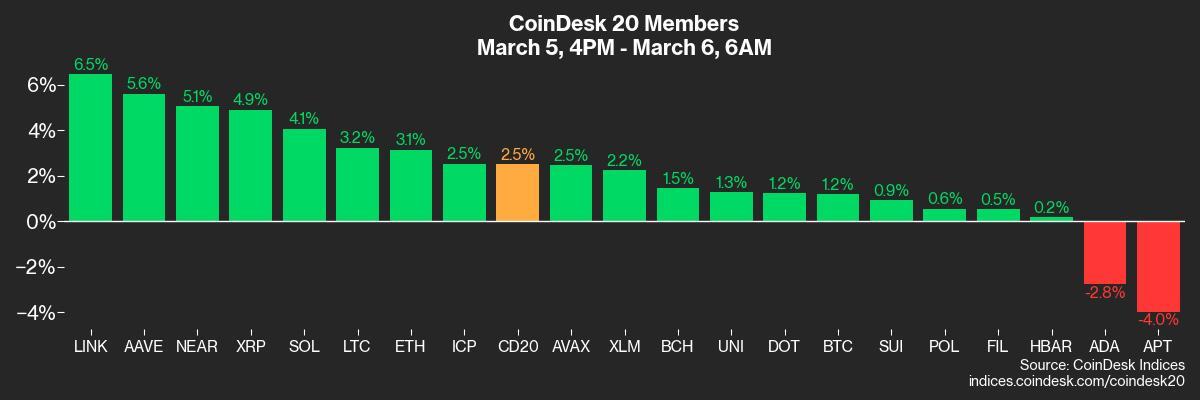
DXY is down 0.11% at 104.16
Gold is down 0.21% at $2,909.10/oz
Silver is up 0.33% at $32.97/oz
Nikkei 225 closed +0.77% at 37,704.93
Hang Seng closed +3.29% at 24,369.71
FTSE is down 1.07% at 8,661.73
Euro Stoxx 50 is down 0.41% at 5,466.55
DJIA closed on Wednesday +1.14% at 43,006.59
S&P 500 closed +1.12% at 5,842.63
Nasdaq closed +1.46% at 18,552.73
S&P/TSX Composite Index closed +1.22% at 24,870.80
S&P 40 Latin America closed +2.43% at 2,342.30
U.S. 10-year Treasury rate is up 2 bps at 4.3%
E-mini S&P 500 futures are down 1.12% at 5,785.75
E-mini Nasdaq-100 futures are down 1.33% at 20,391.00
E-mini Dow Jones Industrial Average Index futures are down 0.95% at 42,658.00
Bitcoin Stats:
BTC Dominance: 61.33 (-0.41%)
Ethereum to bitcoin ratio: 0.02516 (1.74%)
Hashrate (seven-day moving average): 790 EH/s
Hashprice (spot): $50.5
Total Fees: 4.82 BTC / $430,123
CME Futures Open Interest: 144,250 BTC
BTC priced in gold: 31.2 oz
BTC vs gold market cap: 8.85%
Technical Analysis

Bitcoin is pushing against the horizontal resistance line from Jan. 9 and Feb. 3 lows. The next resistance is the descending trendline from record highs.
A failure to surge past these key levels could entice more technical sellers, potentially leading to a re-test of the 200-day average support at around $83K.
Crypto Equities
MicroStrategy (MSTR): closed on Wednesday at $308.55 (+12.14%), down 0.55% at $306.85 in pre-market
Coinbase Global (COIN): closed at $222.45 (+4.66%), down 1.38% at $219.38
Galaxy Digital Holdings (GLXY): closed at C$20.34 (+6.83%)
MARA Holdings (MARA): closed at $15.12 (+8.23%), down 0.4% at $15.06
Riot Platforms (RIOT): closed at $8.88 (+5.59%), down 1.58% at $8.74
Core Scientific (CORZ): closed at $9.60 (+0.1%), down 23.71% at $7.32
CleanSpark (CLSK): closed at $8.55 (+10.18%), down 1.29% at $8.44
CoinShares Valkyrie Bitcoin Miners ETF (WGMI): closed at $17.20 (+5.78%), down 4.48% at $16.43
Semler Scientific (SMLR): closed at $38.37 (+0.03%)
Exodus Movement (EXOD): closed at $29.01 (-31.71%), up 6.48% at $30.89
ETF Flows
Spot BTC ETFs:
Daily net flow: $22.1 million
Cumulative net flows: $36.75 billion
Total BTC holdings ~ 1,128 million.
Spot ETH ETFs
Daily net flow: -$63.3 million
Cumulative net flows: $2.76 billion
Total ETH holdings ~ 3.635 million.
Source: Farside Investors
Overnight Flows
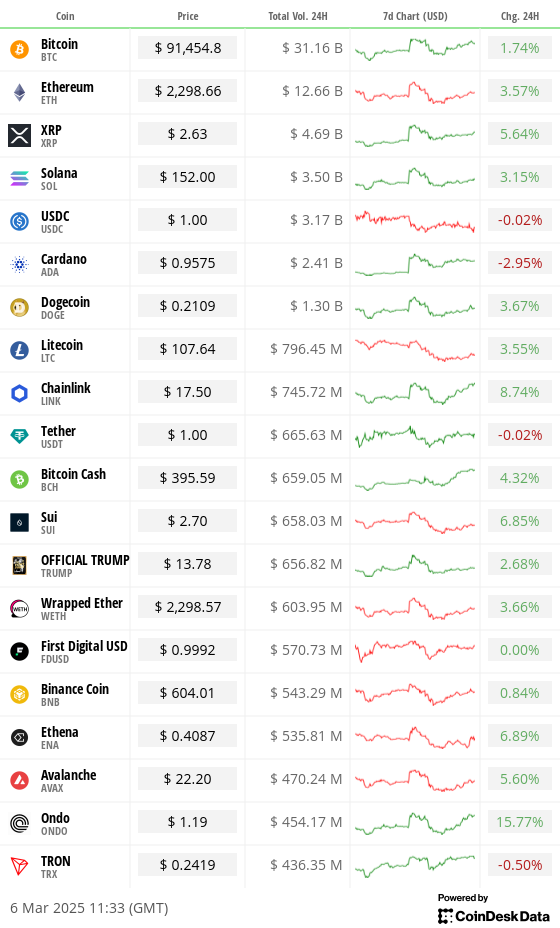
Chart of the Day
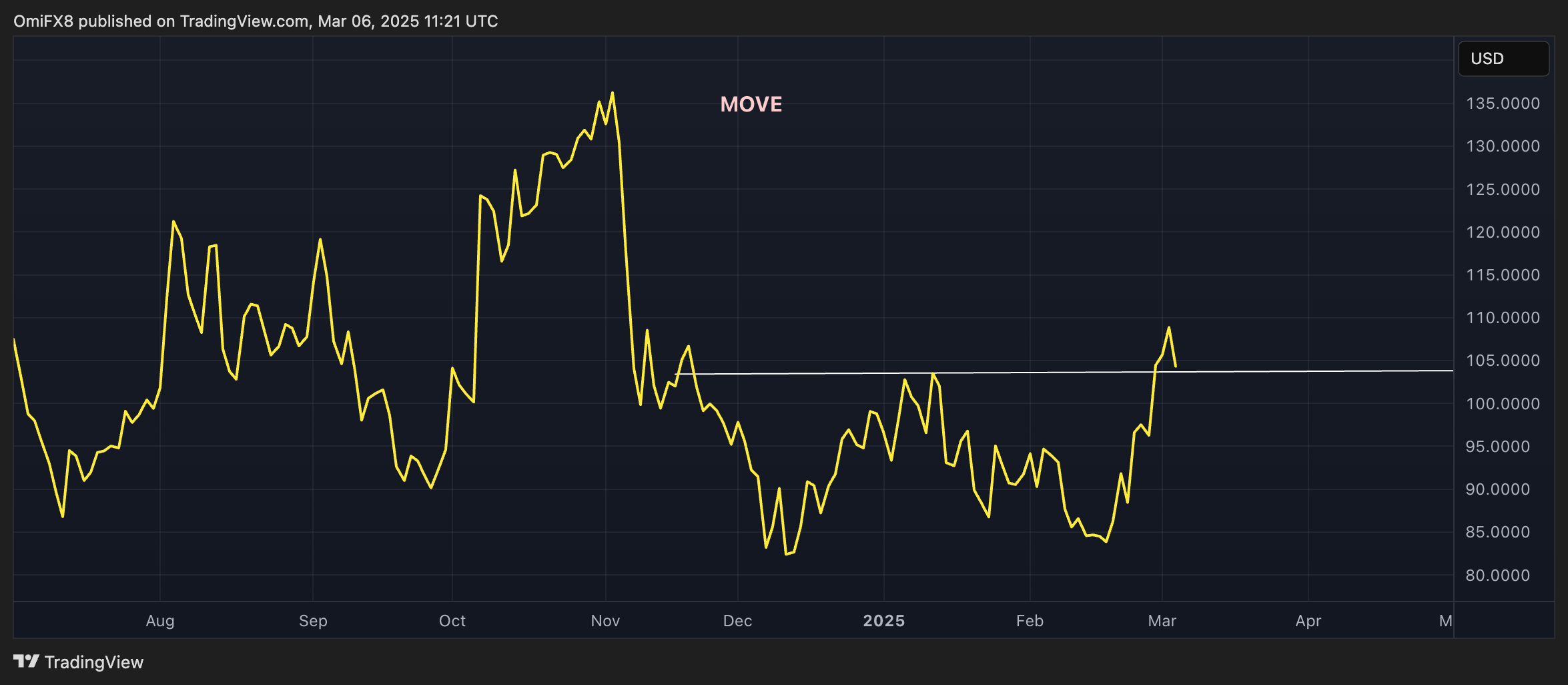
The MOVE index has topped the January high, suggesting increased volatility in the U.S. Treasury notes.
Volatile bonds often cause risk aversion.
While You Were Sleeping
ECB Expected to Cut Interest Rates as Traders Pile Into Fed Easing Bets (CoinDesk): The ECB is expected to cut its key interest rate to 2.65% on Thursday, adding to global liquidity easing and potentially boosting risk assets, including cryptocurrencies.
Bitcoin Surges to $92K, XRP Prices Muted as White House Crypto Summit Looms (CoinDesk): Major cryptocurrencies gained on Thursday ahead of Friday’s White House event, with bitcoin briefly surpassing $92,000 before pulling back.
Trump-Backed World Liberty Financial Snaps Up $21.5M in WBTC, ETH, MOVE: CoinDesk (CoinDesk): On-chain data shows a DeFi startup linked to the Trump family added 4,468 ETH, 110.6 WBTC and 3.42 million MOVE to its treasury on Wednesday.
The Recession Trade Is Back on Wall Street (The Wall Street Journal): U.S. recession fears are rising among analysts and investors as trade war concerns, weakening economic data, and federal government layoffs have dented consumer confidence and sent equity indexes lower.
More Words Than Deeds From China on Consumption Keep Deflation in Play (Reuters): Despite China’s push for fiscal stimulus to boost household spending and counter deflation amid tariff concerns, analysts say bolder structural reforms and stronger welfare measures are needed.
South Korea’s Mint Is Grappling With a Gold Bar Shortage as Supply Constraints Bite (CNBC): Amid political uncertainty and a weakening won, South Korea’s mint suspended gold bar sales last month, with vending machines selling out and banks pausing sales due to tight supply.
In the Ether
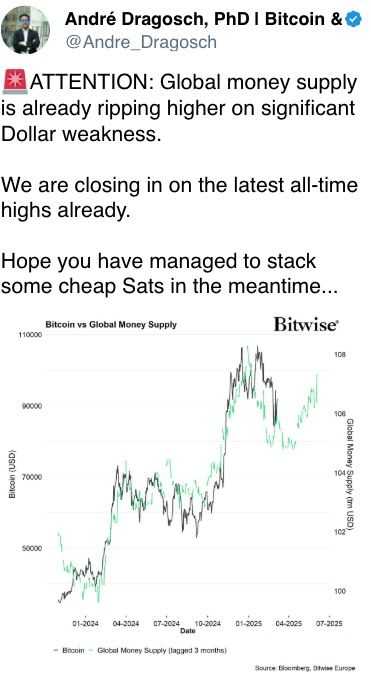

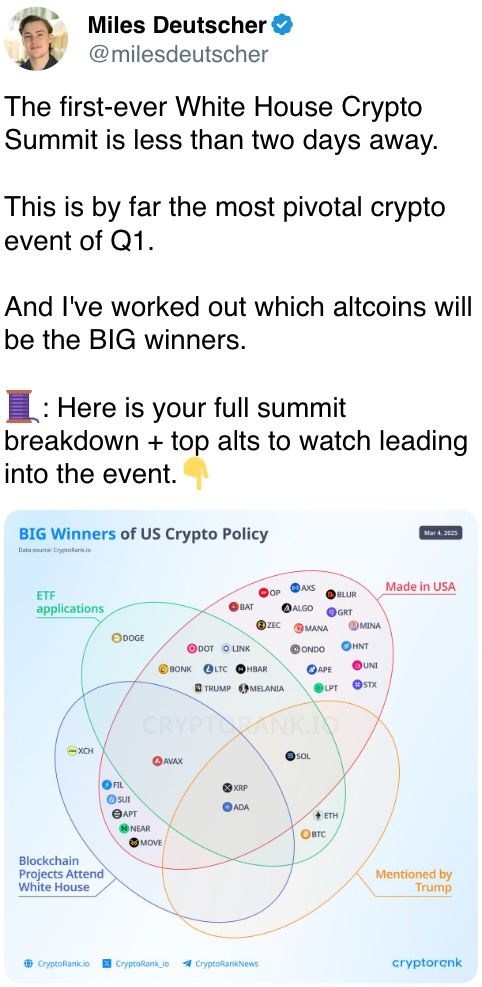
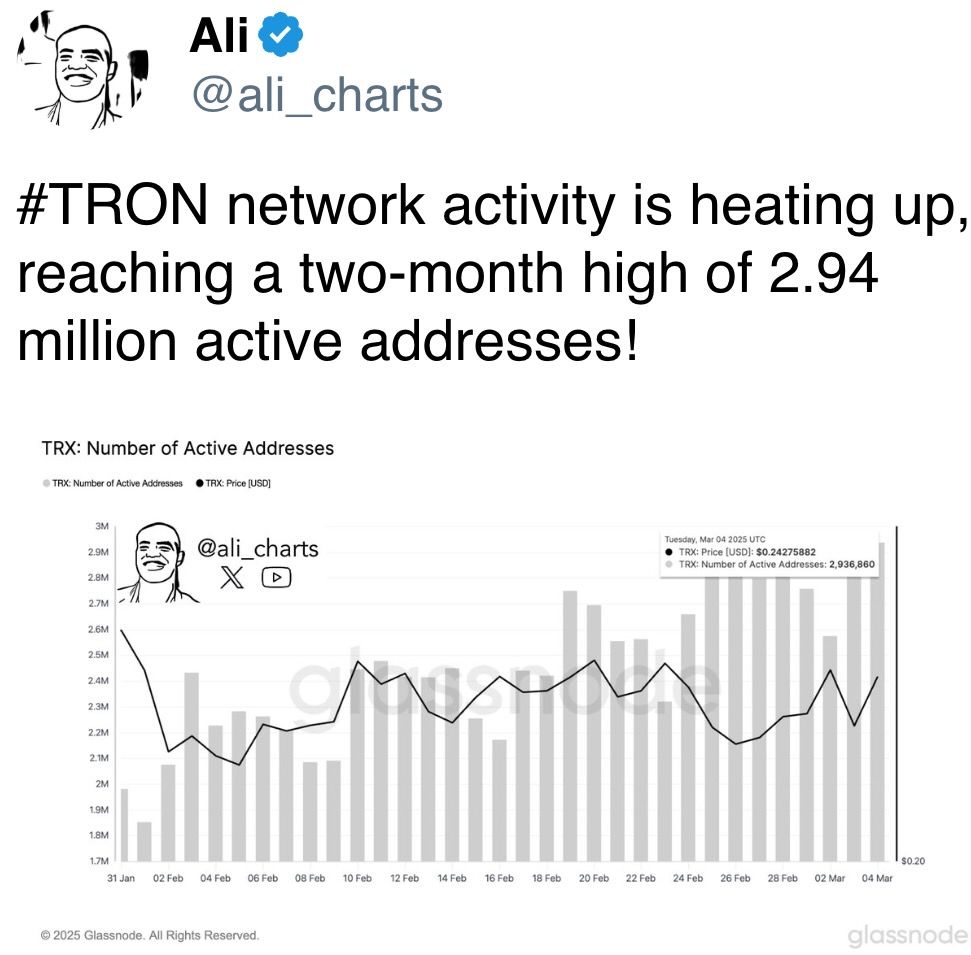

Uncategorized
Asia Morning Briefing: Fragility or Back on Track? BTC Holds the Line at $115K

Good Morning, Asia. Here’s what’s making news in the markets:
Welcome to Asia Morning Briefing, a daily summary of top stories during U.S. hours and an overview of market moves and analysis. For a detailed overview of U.S. markets, see CoinDesk’s Crypto Daybook Americas.
Bitcoin (BTC) traded just above $115k in Asia Tuesday morning, slipping slightly after a strong start to the week.
The modest pullback followed a run of inflows into U.S. spot ETFs and lingering optimism that the Federal Reserve will cut rates next week. The moves left traders divided: is this recovery built on fragile foundations, or is crypto firmly back on track after last week’s CPI-driven jitters?
That debate is playing out across research desks. Glassnode’s weekly pulse emphasizes fragility. While ETF inflows surged nearly 200% last week and futures open interest jumped, the underlying spot market looks weak.
Buying conviction remains shallow, Glassnode writes, funding rates have softened, and profit-taking is on the rise with more than 92% of supply in profit.
Options traders have also scaled back downside hedges, pushing volatility spreads lower, which Glassnode warns leaves the market exposed if risk returns. The core message: ETFs and futures are supporting the rally, but without stronger spot flows, BTC remains vulnerable.
QCP takes the other side.
The Singapore-based desk says crypto is “back on track” after CPI confirmed tariff-led inflation without major surprises. They highlight five consecutive days of sizeable BTC ETF inflows, ETH’s biggest inflow in two weeks, and strength in XRP and SOL even after ETF delays.
Traders, they argue, are interpreting regulatory postponements as inevitability rather than rejection. With the Altcoin Season Index at a 90-day high, QCP sees BTC consolidation above $115k as the launchpad for rotation into higher-beta assets.
The divide underscores how Bitcoin’s current range near $115k–$116k is a battleground. Glassnode calls it fragile optimism; QCP calls it momentum. Which side is right may depend on whether ETF inflows keep offsetting profit-taking in the weeks ahead.
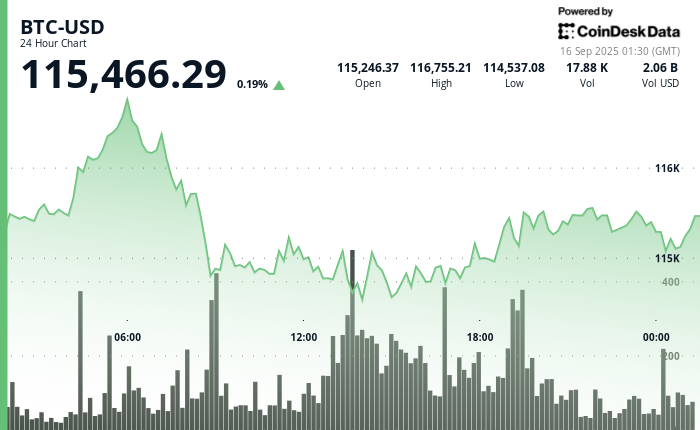
Market Movement
BTC: Bitcoin is consolidating near the $115,000 level as traders square positions ahead of expected U.S. Fed policy moves; institutional demand via spot Bitcoin ETFs is supporting upside
ETH: ETH is trading near $4500 in a key resistance band; gains are being helped by renewed institutional demand, tightening supply (exchange outflows), and positive technical setups.
Gold: Gold continues to hold near record highs, underpinned by expectations of Fed interest rate cuts, inflation risk, and investor demand for safe havens; gains tempered somewhat by profit‑taking and a firmer U.S. dollar
Nikkei 225: Japan’s Nikkei 225 topped 45,000 for the first time Monday, leading Asia-Pacific gains as upbeat U.S.-China trade talks and a TikTok divestment framework lifted sentiment.
S&P 500: The S&P 500 rose 0.5% to close above 6,600 for the first time on Monday as upbeat U.S.-China trade talks and anticipation of a Fed meeting lifted stocks.
Elsewhere in Crypto
Uncategorized
Wall Street Bank Citigroup Sees Ether Falling to $4,300 by Year-End

Wall Street giant Citigroup (C) has launched new ether (ETH) forecasts, calling for $4,300 by year-end, which would be a decline from the current $4,515.
That’s the base case though. The bank’s full assessment is wide enough to drive an army regiment through, with the bull case being $6,400 and the bear case $2,200.
The bank analysts said network activity remains the key driver of ether’s value, but much of the recent growth has been on layer-2s, where value “pass-through” to Ethereum’s base layer is unclear.
Citi assumes just 30% of layer-2 activity contributes to ether’s valuation, putting current prices above its activity-based model, likely due to strong inflows and excitement around tokenization and stablecoins.
A layer 1 network is the base layer, or the underlying infrastructure of a blockchain. Layer 2 refers to a set of off-chain systems or separate blockchains built on top of layer 1s.
Exchange-traded fund (ETF) flows, though smaller than bitcoin’s (BTC), have a bigger price impact per dollar, but Citi expects them to remain limited given ether’s smaller market cap and lower visibility with new investors.
Macro factors are seen adding only modest support. With equities already near the bank’s S&P 500 6,600 target, the analysts do not expect major upside from risk assets.
Read more: Ether Bigger Beneficiary of Digital Asset Treasuries Than Bitcoin or Solana: StanChart
Uncategorized
XLM Sees Heavy Volatility as Institutional Selling Weighs on Price
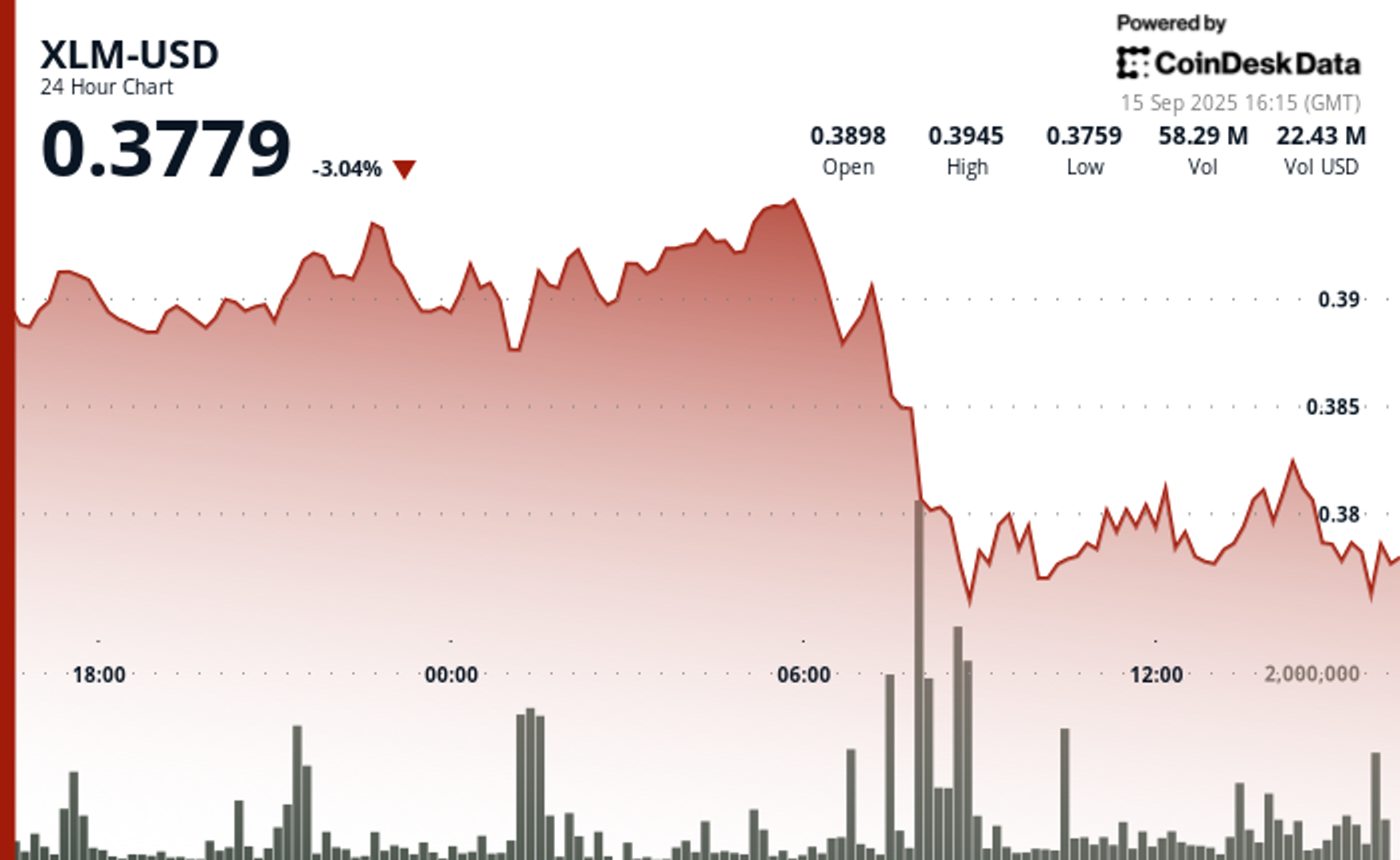
Stellar’s XLM token endured sharp swings over the past 24 hours, tumbling 3% as institutional selling pressure dominated order books. The asset declined from $0.39 to $0.38 between September 14 at 15:00 and September 15 at 14:00, with trading volumes peaking at 101.32 million—nearly triple its 24-hour average. The heaviest liquidation struck during the morning hours of September 15, when XLM collapsed from $0.395 to $0.376 within two hours, establishing $0.395 as firm resistance while tentative support formed near $0.375.
Despite the broader downtrend, intraday action highlighted moments of resilience. From 13:15 to 14:14 on September 15, XLM staged a brief recovery, jumping from $0.378 to a session high of $0.383 before closing the hour at $0.380. Trading volume surged above 10 million units during this window, with 3.45 million changing hands in a single minute as bulls attempted to push past resistance. While sellers capped momentum, the consolidation zone around $0.380–$0.381 now represents a potential support base.
Market dynamics suggest distribution patterns consistent with institutional profit-taking. The persistent supply overhead has reinforced resistance at $0.395, where repeated rally attempts have failed, while the emergence of support near $0.375 reflects opportunistic buying during liquidation waves. For traders, the $0.375–$0.395 band has become the key battleground that will define near-term direction.
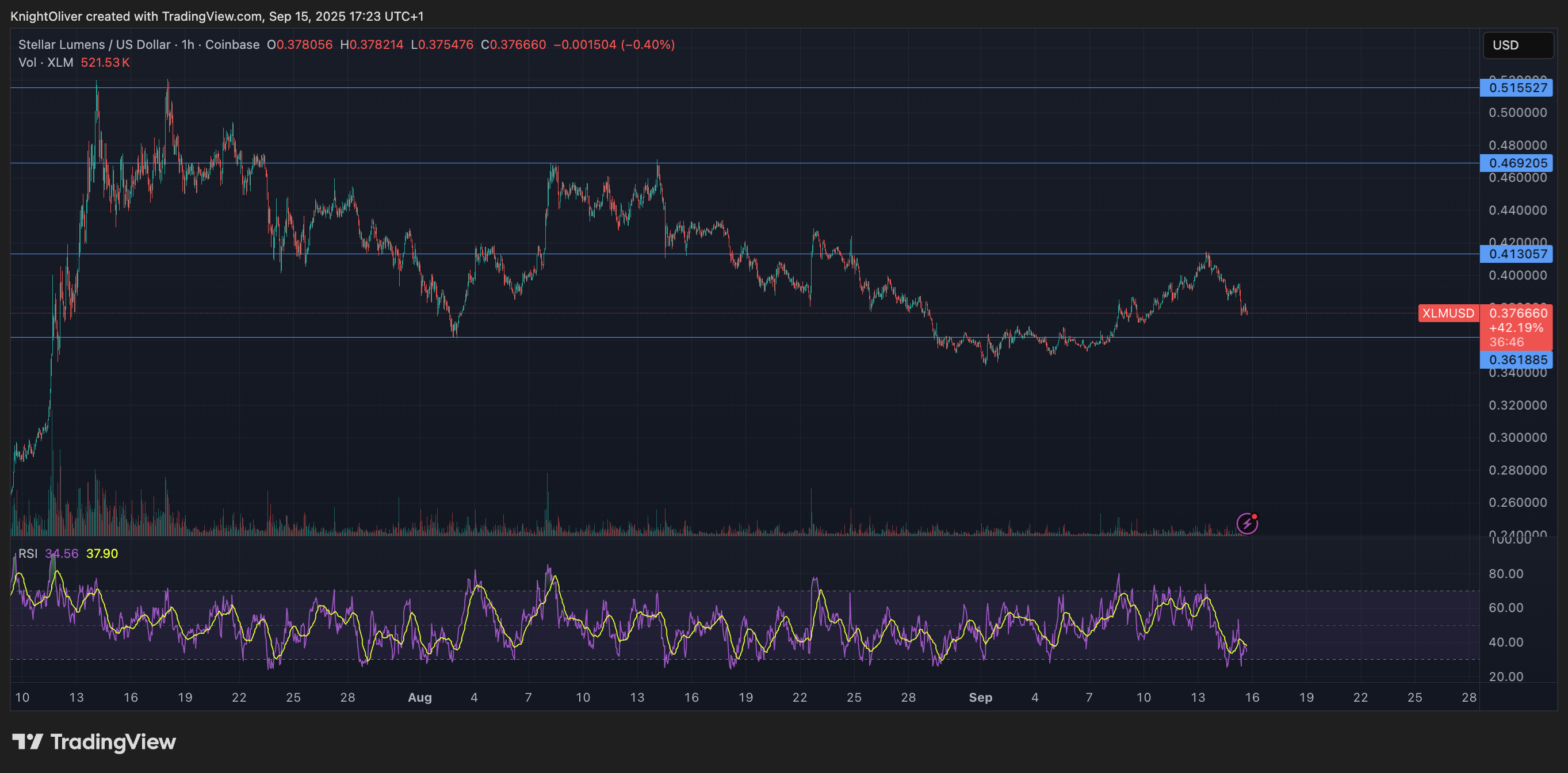
Technical Indicators
- XLM retreated 3% from $0.39 to $0.38 during the previous 24-hours from 14 September 15:00 to 15 September 14:00.
- Trading volume peaked at 101.32 million during the 08:00 hour, nearly triple the 24-hour average of 24.47 million.
- Strong resistance established around $0.395 level during morning selloff.
- Key support emerged near $0.375 where buying interest materialized.
- Price range of $0.019 representing 5% volatility between peak and trough.
- Recovery attempts reached $0.383 by 13:00 before encountering selling pressure.
- Consolidation pattern formed around $0.380-$0.381 zone suggesting new support level.
Disclaimer: Parts of this article were generated with the assistance from AI tools and reviewed by our editorial team to ensure accuracy and adherence to our standards. For more information, see CoinDesk’s full AI Policy.
-

 Business11 месяцев ago
Business11 месяцев ago3 Ways to make your business presentation more relatable
-

 Fashion11 месяцев ago
Fashion11 месяцев agoAccording to Dior Couture, this taboo fashion accessory is back
-

 Entertainment11 месяцев ago
Entertainment11 месяцев ago10 Artists who retired from music and made a comeback
-

 Entertainment11 месяцев ago
Entertainment11 месяцев ago\’Better Call Saul\’ has been renewed for a fourth season
-

 Entertainment11 месяцев ago
Entertainment11 месяцев agoNew Season 8 Walking Dead trailer flashes forward in time
-

 Business11 месяцев ago
Business11 месяцев ago15 Habits that could be hurting your business relationships
-

 Entertainment11 месяцев ago
Entertainment11 месяцев agoMeet Superman\’s grandfather in new trailer for Krypton
-

 Entertainment11 месяцев ago
Entertainment11 месяцев agoDisney\’s live-action Aladdin finally finds its stars





